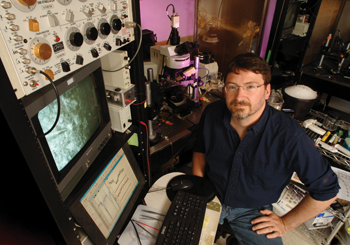
Danny Winder, Ph.D., and his team are studying what drugs of abuse do to the brain and how they go about doing it.
Photo by Anne Rayner
Researchers track how abuse drugs can ‘fry’ the brain
A frying pan. An egg. Sharp sizzling sounds.
These images in a 1980s era ad campaign seared into the collective consciousness a not-so-subtle message: drugs fry the brain. But what exactly do drugs do to the brain, and how do they do it?
Vanderbilt University Medical Center investigators reported last month in The Journal of Neuroscience that cocaine disrupts neuronal activities in a brain region involved in addiction and relapse to drug consumption.
“Our hope is that by understanding, at a molecular level, how drugs of abuse change neural circuitry, we will identify targets for new therapeutics to treat addiction,” said Danny Winder, Ph.D., associate professor of Molecular Physiology & Biophysics.
Winder and colleagues are particularly interested in the long-lasting neuronal changes that mediate relapse behavior, he said, because therapeutic interventions for drug relapse are lacking.
While it can be relatively straightforward — within treatment programs — to “detox” an addicted individual, the rate of relapse to drug abuse is very high, he noted.
Stress is most widely cited by addicted individuals as the reason for relapse. Exposure to drug paraphernalia and environmental situations, like being with the same group of friends, can also promote relapse.
A rodent model for stress-induced reinstatement (relapse) and data from nonhuman primates and humans have implicated a brain region called the “bed nucleus of the stria terminalis” (BNST) in stress-induced relapse behavior.
“We think that the activity of this nucleus regulates other downstream targets that then precipitate reinstatement behavior,” Winder said.
“So things that increase or decrease the likelihood of this nucleus providing output are going to increase or decrease the likelihood of relapse occurring.”
With this in mind, Winder and colleagues have been studying the regulation of neuronal communication in the BNST, in particular the synaptic transmission mediated by the neurotransmitter glutamate.
One of the receptors for glutamate, a “metabotropic” receptor called mGluR5, has been implicated in addiction. Mice without the mGluR5 receptor will not self-administer cocaine (normal mice will), and they show no behavioral responses to cocaine, Winder said.
Winder and colleagues demonstrated that activation of the mGluR5 receptor produces a “long term depression” (LTD) of communication in the BNST region. LTD is a form of synaptic plasticity — the Play-Doh-like capacity for change in connections between neurons. LTD and other types of synaptic plasticity are thought to account for the long-lasting changes that allow us to learn and to remember.
“Addiction is often talked about as a pathological form of learning,” Winder said. “And relapse-related behavior is a lot like retrieval of a stored memory — the same types of stimuli that promote memory retrieval could promote an addict to reinstate drug-using behavior.”
In characterizing the LTD in the BNST, Winder and colleagues discovered that a specific signaling molecule called extracellular-signal regulated kinase-1 (ERK-1) is required. They then examined the effects of cocaine on the LTD by training mice to self-administer the drug and studying the synaptic plasticity after a 10-day period. They found that the LTD was reduced.
“We're excited that this novel molecule — ERK-1 — is involved in what may be an important form of synaptic plasticity. It's certainly a form of plasticity regulated by pathophysiologically-relevant cocaine, because it's cocaine that the animals chose to self-administer,” Winder said.
“ERK-1 could offer a tool to regulate forms of plasticity specifically within the reward circuitry.”
The investigators are now working to understand how cocaine alters plasticity in the BNST. Does it co-opt this form of plasticity in vivo and saturate it, so that the investigators can no longer observe the LTD in vitro? Or does it disrupt the ability for this plasticity to be induced?
The findings will add to the growing list of lasting molecular changes that can explain how drugs of abuse continue to control the brain long after their consumption has ceased, and may one day lead to medications that can counter these effects.
Brad Grueter, Ph.D., a postdoctoral fellow in Winder's laboratory, was the lead author of the paper in The Journal of Neuroscience. Co-authors included Heather B. Gosnell, Christopher M. Olsen, Ph.D. and Nicole L. Schramm-Sapyta, Ph.D. from Winder's laboratory, and collaborators Tanya Nekrasova, Ph.D. and Gary E. Landreth, Ph.D. at Case Western Reserve University. The research was supported by the National Alliance for Research on Schizophrenia and Depression, the National Institute on Drug Abuse, and the National Institute on Alcohol Abuse and Alcoholism.













